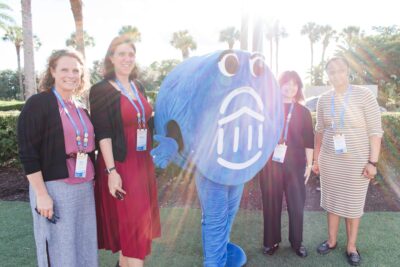Turn dual-enrollment into meaningful college preparatory programs
Stretch roles, new roles beyond your current knowledge or skill level, are universally nerve-wracking—until you get your bearings and start to enjoy your new responsibilities.
I experienced this firsthand when I helped create one of my first major studies at EAB. Although I didn’t quite feel ready to take the reins, the senior researchers on my team provided me with the right mix of assurance and guidance I needed to complete the study and present it to college leaders and executive teams across the country.
Most readers view the final publication, Turning High School Partnerships into College Enrollments, as a strategy guide for strategic recruitment and early preparatory programs—but I see it as a defining stretch role in my career. I pushed past my own doubts and led a study worthy of inclusion in the EAB research library.
In many ways, dual enrollment courses, CTE tracks, and early college high schools can bring out the same feelings of self-doubt in high school students across the country.
Dual-enrollment as a “stretch role” for high school students
Regardless of the circumstances, the majority of students consider post-secondary education scary. Higher education demands an entirely new set of vocabulary, norms, and rules—which can be particularly daunting for those who are first-generation. Taking on these new requirements is a “stretch role” for many high school students.
Unfortunately, most dual-enrollment programs tend to focus on high-performing high school students who are far outside the typical academic profile of a community college student. This means college leaders expend a lot of time, energy, and expense on a population that very rarely attends the school providing these credits. In fact, according to a 2014 EAB analysis, less than 8% of dual-enrollment participants enrolled at the host community college. Instead, the vast majority of dual-enrollment participants use advanced credits to strengthen their applications to four-year universities.
In an era of limited resources and declining enrollments, community college leaders should allocate investments to support students traditionally underserved by dual-enrollment programs—and who are more likely to attend their institutions. These three populations can be seen in the below diagram:

Our study on high school partnerships explores these three student populations in depth and provides over 15 proven best practices to cultivate college navigation skills among “Broken GPS” students, broker accelerated career pathways for the “Future Steve Jobs” of the world, and develop a school-of-choice brand for ‘”Quality Shoppers” seeking the greatest return on their investment in higher education.
In addition to these best practices, we also gathered advice from dual enrollment experts across the country, and uncovered two ways to ensure dual enrollment programs are meaningful pathways to college. The following are two helpful ideas for any college leader or dual enrollment committee member to consider:
Prepare students for higher academic standards and maturity levels in college
It goes without saying that college students are expected to be more self-directed, mature, and intellectually curious than high school students. But for students still in their junior or senior years of high school, the higher standards may not be apparent until they’ve failed to achieve them. In the face of this academic adversity, high school students are likely to retreat from the challenge and give up. College leaders should expect this, and prepare both high school and college faculty members leading dual enrollment courses to encourage persistence and “grit” in their students.
Create early opportunities for meaningful self-exploration and career inquiry
It’s a common question for these students: “What do you want to be when you grow up?” Without experience to go off of, students are expected to know what they want to study and what profession they’ll enter before they’ve even finished their teen years. These are important decisions to make, but college leaders should focus on easing anxiety by being supportive and helpful thought partners to students as they explore classes, topics, and fields that interest them.
Take on the “stretch role” of evolving your dual-enrollment programs
Will transforming your program be easy? Of course not. No stretch role ever is. But just as we encourage high school students to test their limits and try post-secondary work, college leaders should be willing to expand and innovate on their campuses for the benefit of their students. Those stretch roles will translate to increased student success outcomes on your campus—and we can all agree the feelings of fear, doubt, and confusion to get to a moment of self-assurance and resiliency are worth it.
More Blogs

EAB Wrapped 2025: A year of reckoning—and reinvention—in higher ed

Four signs it’s time to break up with your student CRM
